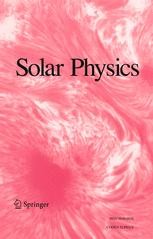Editors' Choice: "Source of Energetic Protons in the 2014 September 1 Sustained Gamma-ray Emission Event"
 Gopalswamy, N., Mäkelä, P., Yashiro, S., Akiyama, Xie, H., Thakur, N., Source of Energetic Protons in the 2014 September 1 Sustained Gamma-ray Emission Event, Sol Phys 295, 18 (2020). https://doi.org/10.1007/s11207-020-1590-8
Gopalswamy, N., Mäkelä, P., Yashiro, S., Akiyama, Xie, H., Thakur, N., Source of Energetic Protons in the 2014 September 1 Sustained Gamma-ray Emission Event, Sol Phys 295, 18 (2020). https://doi.org/10.1007/s11207-020-1590-8
Editor's Choice (Research Article)
Published: 04 February 2020
"This paper presents a very interesting study on the source of the energetic protons at the origin of the sustained gamma-ray emission of 1 September 2014. It uses STEREO B observations of energetic particles to show that enough protons above 300 MeV are produced in the flare/CME to account for the sustained gamma-ray emission (SGRE). It also shows that the properties of the sustained gamma-ray emission and of the IP type II burst for the 1 September 2014 event follow the same rules as the other sustained gamma-ray emission events even if this event originates from well behind the limb. A scenario is proposed to explain the observations based on the reconstruction of the post-eruptive arcade, the flux rope and the shock from combined observations from STEREO B and SOHO."
Abstract:
We report on the source of >300 MeV protons during the SOL2014-09-01 sustained gamma-ray emission (SGRE) event based on multi-wavelength data from a wide array of space- and ground-based instruments. Based on the eruption geometry we provide concrete explanation for the spatially and temporally extended γ-ray emission from the eruption. We show that the associated flux rope is of low inclination (roughly oriented in the east–west direction), which enables the associated shock to extend to the frontside. We compare the centroid of the SGRE source with the location of the flux rope’s leg to infer that the high-energy protons must be precipitating between the flux rope leg and the shock front. The durations of the SOL2014-09-01 SGRE event and the type II radio burst agree with the linear relationship between these parameters obtained for other SGRE events with duration ≥3 hrs. The fluence spectrum of the SEP event is very hard, indicating the presence of high-energy (GeV) particles in this event. This is further confirmed by the presence of an energetic coronal mass ejection with a speed >2000 kms−1, similar to those in ground level enhancement (GLE) events. The type II radio burst had emission components from metric to kilometric wavelengths as in events associated with GLE events. All these factors indicate that the high-energy particles from the shock were in sufficient numbers needed for the production of γ-rays via neutral pion decay.
Solar Physics Editor's Choice:
In each volume of Solar Physics, a few papers are marked as “Editors’ Choice”. The primary criteria is original, high quality research that is of wide interest within the community.
